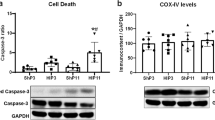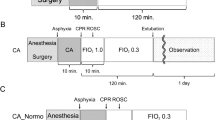Abstract
Transient global brain ischemia induced by cardiac arrest and resuscitation (CAR) results in reperfusion injury associated with oxidative stress. Oxidative stress is known to produce delayed selective neuronal cell loss and impairment of brainstem function, leading to post-resuscitation mortality. Levels of 4-hydroxy-2-nonenal (HNE) modified protein adducts, a marker of oxidative stress, was found to be elevated after CAR in rat brain. In this study we investigated the effects of an antioxidant, alpha-phenyl-tert-butyl-nitrone (PBN) on the recovery following CAR in the aged rat brain. Male Fischer 344 rats (6, 12 and 24-month old) underwent 7-minute cardiac arrest before resuscitation. Brainstem function was assessed by hypoxic ventilatory response (HVR) and HNE-adducts were measured by western blot analysis. Our data showed that in the 24-month old rats, overall survival rate, hippocampal CA1 neuronal counts and HVR were significantly reduced compared to the younger rats. With PBN treatment, the recovery was improved in the aged rat brain, which was consistent with reduced HNE adducts in brain following CAR. Our data suggest that aged rats are more vulnerable to oxidative stress insult and treatment with PBN improves the outcome following reperfusion injury. The mechanism of action is most likely through the scavenging of reactive oxygen species resulting in reduced lipid peroxidation.
Access this chapter
Tax calculation will be finalised at checkout
Purchases are for personal use only
Preview
Unable to display preview. Download preview PDF.
Similar content being viewed by others
References
J.C. Chavez and J.C. LaManna: Activation of hypoxia inducible factor-1 in the rat cerebral cortex after transient global ischemia: potential role of insulin like growth factor-1. J.Neurosci. 22:8922-8931 (2002).
R. C. Crumrine and J.C. LaManna: Regional cerebral metabolites, blood flow, plasma volume and mean transit time in total cerebral ischemia in the rat. J.Cereb.Blood Flow Metab. 11272-282 (1991).
E. D. Hall, P.K. Andrus, J.S. Althaus, and P.F. Von Voigtlander: Hydroxyl radical production and lipid peroxidation parallels selective post-ischemic vulnerability in gerbil brain. J.Neurosci.Res. 34:107-112 (1993).
K. M. Humphries and L.I. Szweda:Selective inactivation of alpha-ketoglutarate dehydrogenase and pyruvate dehydrogenase: reaction of lipoic acid with 4-hydroxy-2- nonenal. Biochem. 37:15835-15841 (1998).
D. T. Lucas and L.I. Szweda: Cardiac reperfusion injury: aging, lipid peroxidation, and mitochondrial dysfunction. Proc Natl.Acad.Sci U.S A 95:-510-514 (1998).
LaManna JC, NL Neubauer, and JC Chàvez: Formation of 4-hydroxy-2-nonenal-modified proteins in the rat brain following transient global ischemia induced by cardiac arrest and resuscitation. In: "Maturation Phenomenon in Cerebral Ischemia IV," Bazan NG et al., eds., Springer-Verlag, Berlin, pp. 223-227 (2001).
7 . J. W. Phillis and C. Clough-Helfman: Protection from cerebral ischemic injury in gerbils with the spin trap agent N-tert-butyl-alpha-phenylnitrone (PBN). Neurosci.Lett. 116:315-319 (1990).
J. M. Hoxworth, K. Xu, Y. Zhou, W.D. Lust, and J.C. LaManna: Cerebral metabolic profile, selective neuronal loss, and survival of acute and chronic hyperglycemic rats following cardiac arrest and resuscitation. Brain Res. 821:467-479 (1999).
Palkovits M and MJ Brownstein: Maps and Guide to Microdissection of the Rat Brain. Elsevier, New York, (1988).
J. V. Weil,E. Byrne-Quinn, I.E. Sodal, W.O. Friesen,B. Underhill, G.F. Filley, and R.F. Grover: Hypoxic ventilatory drive in normal man. J.Clin.Invest. 49:1061-1072 (1970).
Author information
Authors and Affiliations
Editor information
Editors and Affiliations
Rights and permissions
Copyright information
© 2008 Springer Science+Business Media, LLC
About this paper
Cite this paper
Xu, K., Sun, X., Puchowicz, M.A., LaManna, J.C. (2008). Increased Sensitivity to Transient Global Ischemia in Aging Rat Brain. In: Maguire, D.J., Bruley, D.F., Harrison, D.K. (eds) Oxygen Transport to Tissue XXVIII. Advances in Experimental Medicine and Biology, vol 599. Springer, Boston, MA. https://doi.org/10.1007/978-0-387-71764-7_26
Download citation
DOI: https://doi.org/10.1007/978-0-387-71764-7_26
Publisher Name: Springer, Boston, MA
Print ISBN: 978-0-387-71763-0
Online ISBN: 978-0-387-71764-7
eBook Packages: Biomedical and Life SciencesBiomedical and Life Sciences (R0)




